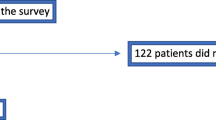Abstract
Objectives: Universal domestic violence (DV) screening once per trimester of pregnancy is recommended but rarely accomplished. Clinical leaders in this setting sought to improve adherence with this protocol. This prospective study used medical record audit and individualized performance feedback with peer comparison (IPF) to improve DV screening among first and second year obstetrics and gynecology (ob/gyn) residents. Methods: The setting is a northeastern, urban, hospital-based, prenatal clinic serving low-income women. Most patients are Latina (75%); 11% are black and 9% are white. Few begin care in the first trimester (8.5%). We gave all residents DV training. Next we gave IPF–four reports at seven-week intervals. We reviewed medical record notes on patient visits corresponding to the first medical encounter and week 16 and week 28 of pregnancy. We used this data to compare screening immediately before IPF and following each IPF report. Results: Screening increased steadily over time, from 60% of appropriate visits before IPF to 91% after the fourth report (Chi Square 28.4, p < .001). Adjusting for key factors, the odds of screening after the last IPF report were seven and a half times greater than the odds of screening before IPF (Odds Ratio: 7.6; 95% Confidence Interval: 3.0, 19.0). Conclusions: IPF was associated with increased DV screening among first and second year ob/gyn residents in this setting. Increased screening improved compliance with the clinic protocol and increased opportunities for patient disclosure, education, and treatment, critical public health objectives.
Similar content being viewed by others
References
American College of Obstetricians and Gynecologists. Screening tools–domestic violence. http://www.acog.org/departments/ dept_notice.cfm?recno=17&bulletin=585. 2005.
American Medical Association. Diagnostic and treatment guidelines on domestic violence. http://www.ama-assn.org/ama/ pub/category/3548.html. 2005.
Covington DL, Diehl SJ, Wright BD, Piner M. Assessing for violence during pregnancy using a systematic approach. Matern Child Health J 1997;1:129–133.
Freund KM, Bak SM, Blackhall L. Identifying domestic violence in primary care practice. J Gen Intern Med 1996;11:44–46.
Harwell TS, Casten RJ, Armstrong KA, Demsey S, Coons HL, Davis M. Results of a domestic violence training program offered to the staff of urban community health centers. Am J Prev Med 1998;15:235–242.
McFarlane J, Christoffel K, Bateman K, Miller V, Bullock L. Assessing for abuse: Self-report versus nurse interview. Public Health Nurs 1991;8:245–250.
Moscati RM, Brynes J, Krasnoff M. Comparison of selective versus inclusive screening for domestic violence in the ED. Acad Emerg Med 2000;7:503.
Norton LB, Peipert JF, Zierler S, Lima B, Hume L. Battering in pregnancy: An assessment of two screening methods. Obstet Gynecol 1995;85:321–325.
Olson LS, Anctil L, Fullerton L, Brillman J, Arbuckle J, Sklar D. Increasing emergency physician recognition of domestic violence. Ann Emerg Med 1996;27:741–746.
Wiist WH, McFarlane J. The effectiveness of an abuse assessment protocol in public health prenatal clinics. Am J Public Health 1999;89:1217–1221.
Chamberlain L, Perham-Hester KA. Physicians’ screening practices for female partner abuse during prenatal visits. Matern Child Health J 2000;4:141–148.
Horan DL, Chapin J, Klein L, Schmidt LA, Schulkin J. Domestic violence screening practice of obstetrician-gynecologists. Obstet Gynecol 1998;92:785–789.
Parsons LH, Zaccaro D, Wells B, Stovall TG. Methods of and attitudes toward screening obstetric and gynecological patients. Am J Obstet Gynecol 1995;173:381–385.
Rodriguez M, Bauer H, McLoughlin E, Grumbach K. Screening and intervention for intimate partner abuse: practices and attitudes of primary care physicians. JAMA 1999;282:468–474.
Stayton CD, Duncan MM. Mutable influences on intimate partner abuse screening in health care settings: a synthesis of the literature. Trauma Violence Abuse 2005;6:271–285.
Davis DA, Thompson MA, Oxman AD, Haynes RB. Changing physician performance: A systematic review of the effect of continuing medical education strategies. JAMA 1995;274:700–705.
Buntinx F, Knottnerus JA, Essed GG, Crebolder HF. Long-term effect of feedback and peer comparison on the sampling quality of cervical smears–a randomized controlled trial. Eur J Cancer Prev 1995;4:153–157.
Holmboe E, Scranton R, Sumption K, Hawkins R. Effect of medical record audit and feedback on residents’ compliance with preventive health care guidelines. Acad Med 1998;73:901–903.
Kern DE, Harris WL, Boekeloo BO, Barker LR, Hogeland P. Use of an outpatient medical record audit to achieve educational objectives: changes in residents’ performances over six years. J Gen Intern Med 1990;5:218–224.
McPhee SJ, Bird JA, Jenkins CNH. Promoting cancer screening. Arch Intern Med 1989;149:1866–1872.
Nattinger AB, Panzer RJ, Janus J. Improving the utilization of screening mammography in primary care practices. Arch Intern Med 1989;149:2087–2092.
Winickoff RN, Coltin KL, Morgan MM, Buxbaum RC, Barnett GO. Improving physician performance through peer comparison feedback. Med Care 1984;22:527–534.
Buntinx F, Knottnerus JA, Crebolder HF, Seegers T, Essed GG, Schouten H. Does feedback improve the quality of cervical smears? A randomized controlled trial. Br J Gen Pract 1993;43:194–198.
Elliott L, Nerney M, Jones T, Friedmann PD. Barriers to screening for domestic violence. J Gen Intern Med 2002;17:112–116.
Shortell SM, Bennett CL, Byck GR. Assessing the impact of continuous quality improvement on clinical practice: What will it take to accelerate progress. Milbank Quarterly 1998;76:593–624.
Grimshaw JM, Shirran L, Thomas R, Mowatt G, Fraser C, Bero L, Grilli R, Harvey E, Oxman A, O’Brien MA. Changing provider behavior: An overview of systematic reviews of interventions. Med Care 2001;39 supplement:II-2–II-45.
Acknowledgements
This study was supported by the Patrick and Catherine Weldon Donaghue Medical Research Foundation. We thank Howard Bailit, DMD, PhD and the clinicians we studied, whose participation made our work possible. We are grateful to Barbara Case, Sandeep Chaudhari, Sally Jett, Angie Mollica, Denise Ortiz, and Angie Rivera for their contributions.
Author information
Authors and Affiliations
Corresponding author
Rights and permissions
About this article
Cite this article
Duncan, M.M., McIntosh, P.A., Stayton, C.D. et al. Individualized performance feedback to increase prenatal domestic violence screening. Matern Child Health J 10, 443–449 (2006). https://doi.org/10.1007/s10995-006-0076-0
Received:
Accepted:
Published:
Issue Date:
DOI: https://doi.org/10.1007/s10995-006-0076-0




